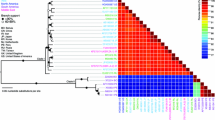Abstract
A potyvirus known to be an important agent involved in causing a disease of trailing petunias, was identified as being a member of the necrotic strain of potato virus Y (PVY) using a number of monoclonal antibodies. The sequence of the coat protein gene for the PVY isolate was determined and when compared with sequences for other PVY strains it was shown to cluster closely with isolates of PVYNTN and to have a recombination point present within the coat protein common with other isolates of PVYNTN. When inoculated onto potato tuber necrotic ringspot disease (PTNRD) susceptible potato cultivars the petunia isolate was found to be capable of causing necrotic tuber symptoms, consistent with those caused by other isolates of PVYNTN. Due to the number of similarities it is thought the petunia isolate belongs to the PVYNTN group of isolates. Out of 24 species of bedding and pot plant crops tested, 19 were shown by mechanical inoculation to be susceptible to PVY, highlighting not only a clear risk to a number of commercially important plant species from PVYNTN infected trailing petunias, but also other susceptible crops grown in these areas.
Similar content being viewed by others
References
Beczner L, Horvath H, Romhanyi I and Forster H (1984) Studies on the aetiology of tuber necrotic ringspot disease in potato. Potato Research 27: 339-352
Bellardi MG, Rubiesautonell C and Vicchi V (1996) Virus infection of sufinia in Italy. Acta Hort 432: 306-310
Blanco-Urgoiti B, Sanchez F, DeSanRoman C, Dopiazo J and Ponz F (1998) Potato virus Y group C isolates are homogeneous pathotype but two different genetic strains. Journal of General Virology 79: 2037-2042
Boonham N and Barker I (1998) Strain specific recombinant antibodies to potato virus Y potyvirus. Journal of Virological Methods 74: 193-199
Bravo-Almonacid F and Mentaberry AN (1989) Nucleotide cDNA sequence coding for the PVYO coat protein. Nucleic Acids Research 17: 4401
Campos G (1995) CSL issue early Surfina alert. Grower 13: 4
Chachulska AM, Chrzanowska M, Robaglia C and Zagorski W (1997) Tobacco veinal necrosis determinants are unlikely to be located within the 5′ and 3′ terminal sequences of the potato virus Y genome. Archives of Virology 142: 765-779
Clark MF and Adams AN (1977) Characteristics of the microplate method of enzyme-linked immunosorbent assay for the detection of plant viruses. Journal of General Virology 34: 475-483
Cockerham G (1970) Genetical studies on resistance to potato viruses X and Y. Heredity, 25: 309-348
De Bokx JA and Huttinga H (1981) Potato virus Y. CMI/AAB Descriptions of plant viruses, 242
Dhar AK and Singh RP (1997) Molecular characterization of coat protein genes of serologically distinct strains of potato virus Y necrotic strain (PVYN). Can J Microbiol 43: 677-683
Edwardson and Christie (1991) The potyvirus group Vol 1–4, Florida Ag. Sta. Monograph 16
Felsenstein J (1989) PHYLIP-phylogeny inference package (version 3.2). Cladistics 5: 164-166
Hataya T, Inoue AK, Ohshima K and Shikata E (1994) Characterization and strain identification of a potato virus Y isolate non-reactive with monoclonal antibodies specific to the ordinary and necrotic strains. Intervirology 37: 12-19
Hay JM, Fellowes AP and Timmerman GM (1989) Nucleotide sequence of the coat protein gene of a necrotic strain of potato virus Y from New Zealand. Archives of Virology 107: 111-122
Hull R (1984) Rapid diagnosis of plant virus infections by spot hybridisation. Trends in Biotechnology 2: 2
Le Romancer M and Nedellec M (1997) Effect of plant genotype, virus isolate and temperature on the expression of the potato tuber necrotic ring disease (PTNRD). Plant Pathology 46: 104-111
Lesemann DE (1996) Viruses recently detected in vegetatively propagated petunia. Acta Hort 432: 88-94
Revers F, Legall O, Candresse, T, Le Romancer M and Dunez J (1996) Frequent occurrence of recombinant potyvirus isolates. Journal of General Virology 77: 1953-1965
Sharp C (1994) Potato virus YN (PVYN) in petunia Surfinia. Plant Disease Notice No 79. Ministry of Agriculture, Fisheries and Food, UK
Shukla DD, Ward CW and Brunt AA (1994) The Potyviridae. Wallingford: CAB International
Sigvald R (1984) The relative efficiency of some aphid species as vectors of potato virus Y. Potato Research 27: 285-290
Spence N, Barker I, O'Neill T and Wright D (1996) Viruses in trailing petunias. HDC Fact Sheet 04/96
Thole V, Dalmay T, Burgyan J and Balazs E (1993) Cloning and sequencing of potato virus Y (Hungarian isolate) genomic RNA. Gene 123: 149-156
Vance VB, Moore D, Turpen TH, Bracker A and Hollowell VC (1992) The complete nucleotide sequence of pepper mottle virus genomic RNA: Comparison of the encoded polyprotein with those of other sequenced potyviruses. Virology 191: 19-30
VanDenHeuvel JFJM, Vandervlught RAA, Verbeek M, Dehaan PT and Huttinga H (1994) Characteristics of a resistance breaking isolate of potato virus Y causing potato tuber necrotic ringspot disease. European Journal of Plant Pathology 100: 347-356
Weidemann HL and Maiss E (1996) Detection of the potato tuber necrotic ringspot strain of potato virus Y (PVYNTN) by reverse transcription and immunocapture polymerase chain reaction. Journal of Plant Diseases and Protection 103: 337-345
Author information
Authors and Affiliations
Corresponding author
Rights and permissions
About this article
Cite this article
Boonham, N., Hims, M., Barker, I. et al. Potato Virus Y from Petunia can cause Symptoms of Potato Tuber Necrotic Ringspot Disease (PTNRD). European Journal of Plant Pathology 105, 617–621 (1999). https://doi.org/10.1023/A:1008715224185
Issue Date:
DOI: https://doi.org/10.1023/A:1008715224185




